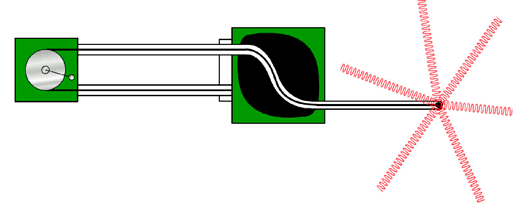Iridium-192 (192Ir)
| PRODUCT SPECIFICATIONS | |
| Product | Iridium-192 [191Ir(n,γ)192Ir] |
| Form | Iridium metal discs |
| Product Dimensions | 2.7 mm (diameter) x 0.150 mm (thickness); other sizes available — please inquire |
| Specific Activity | ~550-600 curies/gram at calibration |
| Shipping Container | Type: 2835A B(U) (Customer supplied) |
| Availability | 10,000-20,000 Ci/months (subject to reactor scheduling) |
Request a Quote

Iridium is a silvery white metal, named after the Latin word for "rainbow" because its salts are highly colored. Iridium is hard and brittle with low ductility, which makes it very difficult to machine and form. It is quite dense, about twice as dense as lead, and occurs in nature as two stable isotopes, Ir-191 and Ir-193. Iridium-193 is the most prevalent isotopic form, comprising about 63% of natural iridium, with Iridium-191 accounting for the balance.
Radioisotope Ir-192 is normally produced by neutron activation of natural-abundance iridium metal, usually in nuclear reactors. The strength (or specific activity) of a resulting Ir-192 is related to the amount of neutron irradiation and length of time to which the natural-abundance iridium metal is exposed. During irradiation only the stable isotope Ir-191 is activated to produce Ir-192 by absorbing a neutron. Radioactive Ir-192 has a half-life of 73.83 days. Neutron absorption by Iridium-193, the other naturally occurring isotope, produces radioactive Ir-194; however, Ir-194 has a short half life of 19 hours, and it decays to the stable isotope Platinum-194 within a few days.
Industrial Applications
Radioactive Ir-192 is used principally for non-destructive testing (NDT) and, to a lesser extent, as a radio-tracer in the oil industry. Industrial gamma radiography involves the testing and grading of welds on pressurized piping, pressure vessels, high-capacity storage containers, pipelines, and certain structural welds. Other tested materials include concrete (locating rebar or conduit within the concrete), machined parts, plate metal, and pipe wall. Gamma radiography is also used to identify flaws in metal castings and welded joints, as well as to indicate structural anomalies due to corrosion or mechanical damage.
Iridium-192 is used in the production of radioactive ”sealed sources” that emit a focused beam of Ir-192 gamma radiation on a target testing material. These sources are typically produced from welded stainless steel, producing a capsule containing a number of Ir-192 metal discs or pellets. The specific activity levels of these sources can range from less than one curie to several hundred curies per gram.
All radioisotope cameras used by the NDT industry are the remote-controlled type. The national code of practice requires that these cameras be essentially safe, whether they are operated manually or by power (electrical or hydraulic).
A wind out camera is one where the radioisotope source is moved from the shielded container to an exposure position outside of the container. The most common form of operation is a Bowden cable fitted to a mechanical winding handle. This cable is attached to a pigtail fitted behind the radioisotope holder, and the source is wound forward through a guide tube or hose to its exposure position. A collimator is normally fitted over the hose at the exposure position to absorb most of the radiation that is emitted in directions not required for the exposure. There are two basic types of wind out cameras, the most common one being the S tube type, illustrated below:

In the shielded position, the source is locked in the center section of the S tube. Radiation travels in straight lines and so cannot escape.
ISOFLEX specializes in supplying Iridium-192 to source fabricators and distributors for industrial radiographic applications.
Medical Application
Iridium-192 is also used medically in brachytherapy to treat various types of cancer. (Brachytherapy is a method of radiation treatment in which sealed sources are used to deliver a radiation dose at a distance of up to a few centimeters by surface, intracavitary or interstitial application.) Ir-192 implants are also used, especially in the head and breast. They are produced in wire form and are introduced through a catheter to the target area. After being left in place for the time required to deliver the desired dose, the implant wire is removed. This procedure is very effective at providing localized radiation to the tumor site while minimizing the patient's whole body dose.
At the present time, ISOFLEX does not supply Ir-192 for medical application, although long-term supply inquiries are welcome.
If you would like to receive further information regarding Iridium-192,
please click here and provide detailed requirements.



